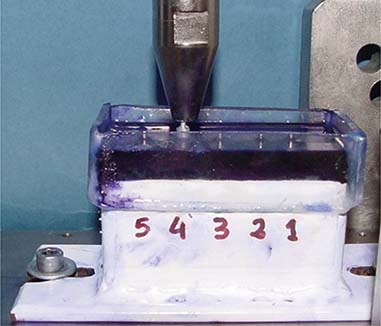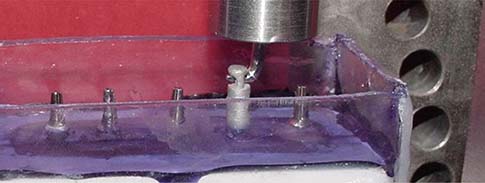J Adv Prosthodont.
2016 Apr;8(2):144-149. 10.4047/jap.2016.8.2.144.
The selection criteria of temporary or permanent luting agents in implant-supported prostheses: in vitro study
- Affiliations
-
- 1Department of Prosthodontics and Occlusion, School of Dentistry, University of Oviedo, Oviedo, Spain. arenal@uniovi.es
- 2Department of Oral Stomatology I, Faculty of Medicine and Dentistry, University of Basque Country, Bilbao, Spain.
- KMID: 2176656
- DOI: http://doi.org/10.4047/jap.2016.8.2.144
Abstract
- PURPOSE
The use of temporary or permanent cements in fixed implant-supported prostheses is under discussion. The objective was to compare the retentiveness of one temporary and two permanent cements after cyclic compressive loading.
MATERIALS AND METHODS
The working model was five solid abutments screwed to five implant analogs. Thirty Cr-Ni alloy copings were randomized and cemented to the abutments with one temporary (resin urethane-based) or two permanent (resin-modified glass ionomer, resin-composite) cements. The retention strength was measured twice: once after the copings were cemented and again after a compressive cyclic loading of 100 N at 0.72 Hz (100,000 cycles).
RESULTS
Before loading, the retention strength of resin composite was 75% higher than the resin-modified glass ionomer and 2.5 times higher than resin urethane-based cement. After loading, the retentiveness of the three cements decreased in a non-uniform manner. The greatest percentage of retention loss was shown by the temporary cement and the lowest by the permanent resin composite. However, the two permanent cements consistently show high retention values.
CONCLUSION
The higher the initial retention of each cement, the lower the percentage of retention loss after compressive cyclic loading. After loading, the resin urethane-based cement was the most favourable cement for retrieving the crowns and resin composite was the most favourable cement to keep them in place.
Keyword
MeSH Terms
Figure
Reference
-
1. Sailer I, Mühlemann S, Zwahlen M, Hämmerle CH, Schneider D. Cemented and screw-retained implant reconstructions: a systematic review of the survival and complication rates. Clin Oral Implants Res. 2012; 23:163–201. Suppl 6.2. Nissan J, Narobai D, Gross O, Ghelfan O, Chaushu G. Longterm outcome of cemented versus screw-retained implantsupported partial restorations. Int J Oral Maxillofac Implants. 2011; 26:1102–1107.3. Vigolo P, Givani A, Majzoub Z, Cordioli G. Cemented versus screw-retained implant-supported single-tooth crowns: a 4-year prospective clinical study. Int J Oral Maxillofac Implants. 2004; 19:260–265.4. Michalakis KX, Hirayama H, Garefis PD. Cement-retained versus screw-retained implant restorations: a critical review. Int J Oral Maxillofac Implants. 2003; 18:719–728.5. Shadid R, Sadaqa N. A comparison between screw- and cement-retained implant prostheses. A literature review. J Oral Implantol. 2012; 38:298–307.6. Chaar MS, Att W, Strub JR. Prosthetic outcome of cementretained implant-supported fixed dental restorations: a systematic review. J Oral Rehabil. 2011; 38:697–711.7. Kent DK, Koka S, Froeschle ML. Retention of cemented implant-supported restorations. J Prosthodont. 1997; 6:193–196.8. Covey DA, Kent DK, St Germain HA Jr, Koka S. Effects of abutment size and luting cement type on the uniaxial retention force of implant-supported crowns. J Prosthet Dent. 2000; 83:344–348.9. Proussaefs P. Crowns cemented on crown preparations lacking geometric resistance form. Part II: effect of cement. J Prosthodont. 2004; 13:36–41.10. Michalakis K, Pissiotis AL, Kang K, Hirayama H, Garefis PD, Petridis H. The effect of thermal cycling and air abrasion on cement failure loads of 4 provisional luting agents used for the cementation of implant-supported fixed partial dentures. Int J Oral Maxillofac Implants. 2007; 22:569–574.11. Chandra Shekar S, Giridhar K, Suhas Rao K. An in vitro study to evaluate the retention of complete crowns prepared with five different tapers and luted with two different cements. J Indian Prosthodont Soc. 2010; 10:89–95.12. Sheets JL, Wilcox C, Wilwerding T. Cement selection for cement-retained crown technique with dental implants. J Prosthodont. 2008; 17:92–96.13. Maeyama H, Sawase T, Jimbo R, Kamada K, Suketa N, Fukui J, Atsuta M. Retentive strength of metal copings on prefabricated abutments with five different cements. Clin Implant Dent Relat Res. 2005; 7:229–234.14. Garg P, Gupta G, Prithviraj DR, Pujari M. Retentiveness of various luting agents used with implant-supported prostheses: a preliminary in vitro study. Int J Prosthodont. 2013; 26:82–84.15. Squier RS, Agar JR, Duncan JP, Taylor TD. Retentiveness of dental cements used with metallic implant components. Int J Oral Maxillofac Implants. 2001; 16:793–798.16. Cano-Batalla J, Soliva-Garriga J, Campillo-Funollet M, Munoz-Viveros CA, Giner-Tarrida L. Influence of abutment height and surface roughness on in vitro retention of three luting agents. Int J Oral Maxillofac Implants. 2012; 27:36–41.17. Mansour A, Ercoli C, Graser G, Tallents R, Moss M. Comparative evaluation of casting retention using the ITI solid abutment with six cements. Clin Oral Implants Res. 2002; 13:343–348.18. Michalakis KX, Pissiotis AL, Hirayama H. Cement failure loads of 4 provisional luting agents used for the cementation of implant-supported fixed partial dentures. Int J Oral Maxillofac Implants. 2000; 15:545–549.19. Dudley JE, Richards LC, Abbott JR. Retention of cast crown copings cemented to implant abutments. Aust Dent J. 2008; 53:332–339.20. Pan YH, Ramp LC, Lin CK, Liu PR. Retention and leakage of implant-supported restorations luted with provisional cement: a pilot study. J Oral Rehabil. 2007; 34:206–212.21. Pan YH, Ramp LC, Lin CK, Liu PR. Comparison of 7 luting protocols and their effect on the retention and marginal leakage of a cement-retained dental implant restoration. Int J Oral Maxillofac Implants. 2006; 21:587–592.22. Kaar D, Oshida Y, Andres CJ, Barco MT, Platt JA. The effect of fatigue damage on the force required to remove a restoration in a cement-retained implant system. J Prosthodont. 2006; 15:289–294.23. Bresciano M, Schierano G, Manzella C, Screti A, Bignardi C, Preti G. Retention of luting agents on implant abutments of different height and taper. Clin Oral Implants Res. 2005; 16:594–598.24. Bernal G, Okamura M, Muñoz CA. The effects of abutment taper, length and cement type on resistance to dislodgement of cement-retained, implant-supported restorations. J Prosthodont. 2003; 12:111–115.25. Akashia AE, Francischone CE, Tokutsune E, da Silva W Jr. Effects of different types of temporary cements on the tensile strength and marginal adaptation of crowns on implants. J Adhes Dent. 2002; 4:309–315.26. Alfaro MA, Papazoglou E, McGlumphy EA, Holloway JA. Short-term retention properties of cements for retrievable implant-supported prostheses. Eur J Prosthodont Restor Dent. 2004; 12:33–37.27. Clayton GH, Driscoll CF, Hondrum SO. The effect of luting agents on the retention and marginal adaptation of the CeraOne implant system. Int J Oral Maxillofac Implants. 1997; 12:660–665.28. Wolfart M, Wolfart S, Kern M. Retention forces and seating discrepancies of implant-retained castings after cementation. Int J Oral Maxillofac Implants. 2006; 21:519–525.29. Nejatidanesh F, Savabi O, Ebrahimi M, Savabi G. Retentiveness of implant-supported metal copings using different luting agents. Dent Res J (Isfahan). 2012; 9:13–18.30. Ongthiemsak C, Mekayarajjananonth T, Winkler S, Boberick KG. The effect of compressive cyclic loading on retention of a temporary cement used with implants. J Oral Implantol. 2005; 31:115–120.31. Koolstra JH, van Eijden TM. Prediction of volumetric strain in the human temporomandibular joint cartilage during jaw movement. J Anat. 2006; 209:369–380.32. Hallgren C, Sawase T, Ortengren U, Wennerberg A. Histomorphometric and mechanical evaluation of the bonetissue response to implants prepared with different orientation of surface topography. Clin Implant Dent Relat Res. 2001; 3:194–203.
- Full Text Links
- Actions
-
Cited
- CITED
-
- Close
- Share
- Similar articles
-
- Effects of various cements and thermocycling on retentive strengths of cemented implant-supported prostheses
- Complete mouth rehabilitation with fixed implant-supported prosthesis using temporary denture and dental CAD-CAM
- Implant Surgery for Fixed Implant-supported Prostheses in the Edentulous Mandible: A Case Report
- Mounting and utilization of provisional prostheses on master cast for the fabrication of fixed implant-supported prostheses: a case report
- Implant-assisted removable partial denture restoration in small number of residual teeth in mandible: A case report




